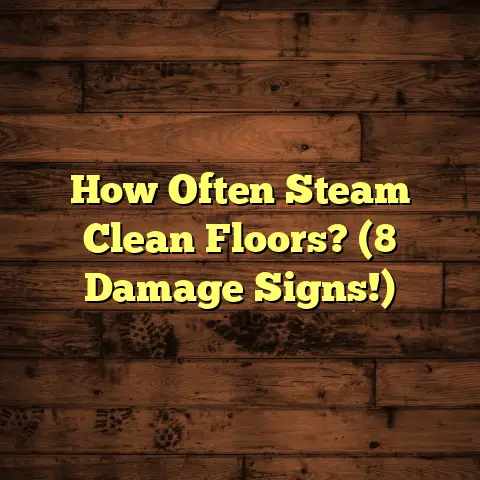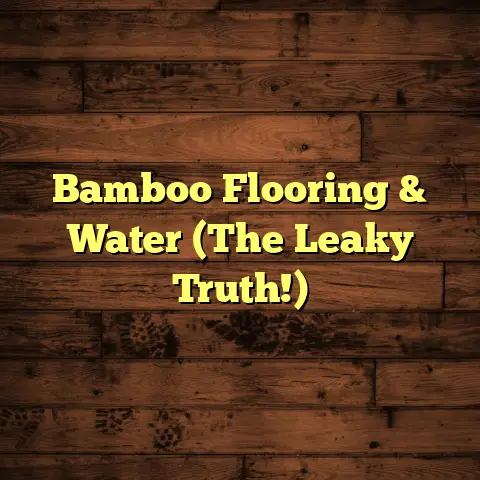Sticky Residue On Wood? (6 Quick Fixes!)
Ever hosted a party where your guests ended up more attached to the floor than the conversation?
I’ve seen it happen!
There’s a certain irony in how we admire the beauty and elegance of wooden floors, yet they can quickly turn from a stunning feature to a sticky nightmare.
One minute, you’re admiring the grain; the next, you’re peeling someone’s shoe off a mysterious patch.
It’s a classic case of wood flooring: Beautiful, yet deceptively troublesome.
Don’t worry, though!
I’m here to help you reclaim your floors from the sticky abyss.
Section 1: Understanding the Problem
Okay, let’s get down to brass tacks.
What exactly is this sticky residue we’re battling?
Simply put, it’s any foreign substance that clings stubbornly to your wood floor, making it feel tacky or gummy to the touch.
Think of it as the uninvited guest that refuses to leave the party.
Common Culprits:
- Spilled Drinks: Soda, juice, wine – these sugary substances dry and become incredibly sticky.
- Cleaning Product Buildup: Using the wrong cleaner or too much of the right one can leave a residue over time.
- Humidity: High humidity can react with certain finishes, causing them to become tacky.
I’ve seen this happen a lot in coastal areas. - Food Splatters: Cooking mishaps happen! Grease and food particles can create a sticky mess.
- Adhesive Residue: From tape, stickers, or even old flooring adhesives.
Why Wood Attracts Stickiness:
Wood is porous, meaning it has tiny openings that can trap liquids and substances.
The finish on your floor is meant to protect it, but it can also become a magnet for sticky buildup if not properly maintained.
Why Address It Promptly?
Ignoring sticky residue isn’t just an aesthetic issue. It can:
- Damage the finish over time.
- Attract more dirt and grime.
- Become a safety hazard (slippery floors!).
- Be a general nuisance.
So, let’s get to those fixes!
Section 2: Quick Fix #1 – The Vinegar Solution
Ah, vinegar – the multi-purpose champion of the cleaning world!
It’s cheap, effective, and readily available.
How It Works:
Vinegar’s acidity helps to break down sticky residues without harsh chemicals.
Step-by-Step Guide:
- Mix It Up: Combine equal parts white vinegar and warm water in a spray bottle.
I usually start with 1 cup of each. - Test Patch: Before going wild, spray a small, inconspicuous area (like under a rug or in a closet) to ensure the vinegar doesn’t damage the finish.
Wait about 30 minutes and check for discoloration or dulling. - Apply: Lightly spray the sticky area with the vinegar solution. Don’t saturate the wood!
- Wipe: Use a clean, damp (not soaking wet!) microfiber cloth to wipe away the residue.
Wring out the cloth frequently. - Dry: Immediately dry the area with another clean, dry microfiber cloth.
Moisture is the enemy of wood!
Tips:
- Use white vinegar, not apple cider or other types.
- For stubborn spots, let the vinegar solution sit for a few minutes before wiping.
- Always dry the floor thoroughly.
I once had a client who swore by vinegar for everything, and her floors looked amazing!
She attributed it to consistent, gentle cleaning.
Section 3: Quick Fix #2 – Dish Soap and Warm Water
Sometimes, the simplest solutions are the best.
Good old dish soap and warm water can work wonders on sticky residue.
How It Works:
Dish soap is designed to cut through grease and grime, making it effective at breaking down sticky substances.
The Method:
- Mix It Up: Add a few drops of mild dish soap to a bucket of warm water.
I recommend using a soap that’s gentle and pH-neutral. - Apply: Dip a clean microfiber cloth into the soapy water, wring it out thoroughly, and wipe the sticky area.
Again, avoid saturating the wood. - Rinse (Lightly!): Use a separate cloth dampened with clean water to lightly rinse the area.
This removes any soap residue. - Dry: Immediately dry the area with a clean, dry microfiber cloth.
Safety Precautions:
- Use a mild dish soap. Avoid anything with harsh chemicals or abrasives.
- Don’t use too much soap. It can leave a residue of its own.
- Always wring out the cloth thoroughly to prevent water damage.
I had a situation where a client used too much dish soap, and it left a dull film on their floor.
It took a few rounds of rinsing with clean water to fix it.
Less is more!
Section 4: Quick Fix #3 – Baking Soda Paste
Baking soda is another cleaning powerhouse that can absorb stickiness and odors.
How It Works:
Baking soda is a mild abrasive that can gently scrub away residue.
It also has absorbent properties, which help to draw out sticky substances.
The Recipe & Application:
- Make the Paste: Mix baking soda with a small amount of water to form a thick paste.
I usually start with a few tablespoons of baking soda and add water until I get the right consistency. - Apply: Apply the paste to the sticky area.
- Let It Sit: Allow the paste to sit for 15-30 minutes.
This gives it time to absorb the residue. - Wipe Away: Use a damp (not soaking wet!) cloth to gently wipe away the paste.
You might need to scrub lightly. - Clean & Dry: Clean the area with a damp cloth and then dry thoroughly.
Additional Cleaning Steps:
- If there’s any baking soda residue left, use a vinegar solution (as described earlier) to neutralize it.
- Make sure the area is completely dry to prevent water damage.
I once used baking soda paste to remove a stubborn sticker residue from a hardwood floor, and it worked like a charm.
The key is to be patient and let the paste do its job.
Section 5: Quick Fix #4 – Rubbing Alcohol
Rubbing alcohol (isopropyl alcohol) can be very effective at dissolving sticky residue.
How It Works:
Rubbing alcohol is a solvent that can break down many types of sticky substances.
Safety First!
- Finish Type: This is crucial! Rubbing alcohol can damage certain wood finishes, especially shellac or varnish.
Always test it in an inconspicuous area first. - Ventilation: Use rubbing alcohol in a well-ventilated area.
- Flammability: Rubbing alcohol is flammable, so keep it away from open flames or heat sources.
The Method:
- Test Patch: As always, test in a hidden area first!
- Apply: Dampen a clean cloth with rubbing alcohol. Don’t saturate the cloth.
- Wipe: Gently wipe the sticky area with the dampened cloth. Avoid scrubbing aggressively.
- Clean Up: Immediately wipe the area with a damp cloth to remove any alcohol residue.
- Dry: Dry thoroughly with a clean cloth.
Important Considerations:
- Use a high concentration of rubbing alcohol (70% or higher) for best results.
- Work quickly to minimize the alcohol’s contact time with the finish.
- If the finish starts to look dull or damaged, stop immediately and try a different method.
I’ve seen rubbing alcohol work wonders on removing adhesive residue, but it’s definitely a method to approach with caution.
Always test, test, test!
Section 6: Quick Fix #5 – Commercial Adhesive Removers
Sometimes, you need to bring in the big guns.
Commercial adhesive removers are specifically designed to tackle stubborn sticky residues.
Choosing the Right Product:
- Read the Label: Look for products that are specifically formulated for use on wood floors.
Avoid anything that contains harsh chemicals or abrasives. - Ingredients: Consider products with natural ingredients, such as citrus-based solvents.
These tend to be gentler on wood finishes. - Reviews: Check online reviews to see what other users have experienced with the product.
Safe Application:
- Read the Instructions: Follow the manufacturer’s instructions carefully.
- Test Patch: You know the drill! Test in an inconspicuous area first.
- Apply: Apply the remover to a clean cloth, not directly to the floor.
- Wipe: Gently wipe the sticky area with the cloth. Avoid scrubbing.
- Clean Up: Wipe the area with a damp cloth to remove any remover residue.
- Dry: Dry thoroughly with a clean cloth.
Potential Risks & Downsides:
- Harsh Chemicals: Some commercial removers contain harsh chemicals that can damage wood finishes.
- Cost: Commercial removers can be more expensive than natural alternatives.
- Fumes: Some removers have strong fumes, so use them in a well-ventilated area.
I’ve used commercial adhesive removers on particularly stubborn residues, but I always prefer to try natural methods first.
It’s all about finding the right balance between effectiveness and safety.
Section 7: Quick Fix #6 – Refinishing the Wood
Okay, let’s be honest.
Sometimes, the sticky residue is so stubborn or has caused so much damage that the only solution is to refinish the wood.
When to Consider Refinishing:
- Extensive Damage: If the sticky residue has damaged the finish or stained the wood.
- Multiple Attempts Failed: If you’ve tried all the other methods and nothing has worked.
- Old or Worn Finish: If the finish is already old or worn, refinishing can restore the floor’s beauty and protect it from future damage.
The Refinishing Process (Brief Overview):
- Sanding: The old finish is sanded away to reveal the bare wood.
This requires specialized equipment and can be quite dusty. - Staining (Optional): If you want to change the color of the wood, you can apply a stain.
- Sealing: Several coats of sealant (such as polyurethane) are applied to protect the wood and provide a durable finish.
DIY vs. Hiring a Professional:
- DIY: Refinishing a wood floor is a challenging DIY project that requires skill, patience, and the right equipment.
It can be cost-effective, but it’s easy to make mistakes that can damage the floor. - Hiring a Professional: Hiring a professional flooring contractor can ensure a high-quality finish and minimize the risk of damage.
It’s more expensive, but it’s often worth the investment.
Assessing the Condition of the Wood:
Before refinishing, it’s important to assess the condition of the wood. Look for:
- Warping or cupping: This can indicate moisture damage.
- Splitting or cracking: This can weaken the floor.
- Insect damage: This can compromise the structural integrity of the wood.
If the wood is severely damaged, it may need to be replaced before refinishing.
I’ve seen homeowners attempt DIY refinishing projects with disastrous results.
Unless you’re experienced and confident, I highly recommend hiring a professional.
Conclusion
Sticky residue on wood floors can be a real pain, but it’s not a battle you have to lose.
From simple vinegar solutions to commercial adhesive removers, there are several straightforward ways to restore the beauty of your wood floors.
Key Takeaways:
- Act quickly to address sticky residue before it causes permanent damage.
- Always test any cleaning method in an inconspicuous area first.
- Avoid using harsh chemicals or abrasives that can damage the finish.
- Dry the floor thoroughly after cleaning to prevent water damage.
- If all else fails, consider refinishing the floor.
Don’t let sticky residue diminish the elegance of your wood flooring.
With a little effort and the right techniques, you can keep your floors looking beautiful for years to come.
Now go forth and conquer that stickiness!
Your floors (and your guests’ shoes) will thank you.





